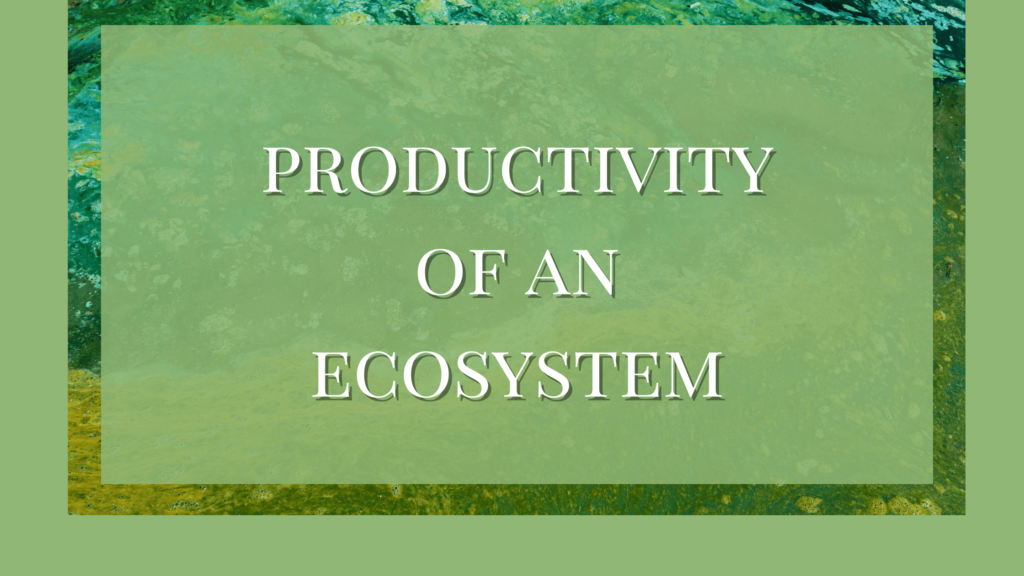The total weight of dry matter present in an ecosystem at any time is called biomass. The rate of synthesis of energy-containing organic matter by any trophic level per unit area in unit time is described as its productivity. The productivity of an ecosystem is expressed in units of mass per unit area or volume per unit of time. Both productivity and products are interchangeable.
Production ecology is a branch of ecology that deals with the rate of production of organic matter in different components of an ecosystem. Productivity is different from biomass. While productivity is the rate of organic matter production, biomass is the amount of matter produced at any given time.
Productivity of an Ecosystem
Productivity is of the following types.
Primary Productivity
The amount of energy accumulation in green plants through photosynthesis is called primary productivity. In other words, it is the rate of biomass production per unit area by the primary producers like photoautotrophs and chemoautotrophs.
Primary productivity is concerned with the primary trophic level. It is also a fundamental process in the ecosystem and the first step of capturing energy. It has two subtypes.
- Gross primary productivity (GPP): The total organic matter synthesized by producers through photosynthesis per unit time and area is called gross primary productivity. It includes the weight of organic matter added to the body of producers and the losses due to respiration and other damages.
- Net primary productivity (NPP): The plants use a part of this gross production for respiration. The difference between the rate of real photosynthesis and the rate of respiration represents the real weight of plants. This difference is the net primary productivity or net assimilation.
Net Primary Productivity = Gross Primary Productivity – Respiration by autotrophs
NPP= GPP – R,
GPP = NPP + R
NPP = the actual rate of biomass production that is available for consumption for heterotrophs.
Each trophic level of the ecosystem has a certain amount of biomass. This is used to generate energy for their activities, during which a small amount is lost as heat. The remaining amount is available for the organisms in the next trophic level. Thus the energy of an ecosystem in the primary trophic level that is available for the next level is the net primary productivity.
What is Secondary Productivity?
The secondary productivity of an ecosystem is the rate of organic matter synthesis by consumers. The consumers (animals) get only a part of the potential energy as a good portion of it is used by green plants for their growth and reproduction or it is lost as heat during energy transfer.
Animals convert plant food into new types of food materials through digestion. Consumers are thus engaged in the process of organic production known as secondary production.
Primary producers synthesize organic matter from inorganic materials and secondary producers can only convert one kind of organic food into another. Eg. Fat, protein, lipids, etc can be converted into glucose.
The animals or first consumers utilize a part of food energy in respiration and what is left is called net secondary productivity. Thus the heterotrophic organisms at each step of the food chain (trophic level) act as consumers and secondary producers for the next trophic level until the energy reaches the top carnivore level.
Significance of Organic Productivity
The net primary productivity of an ecosystem is of great significance. It is expressed as the total increase in dry matter of all plant parts like root, stem and leaves, fruit, etc, in a season or year. In agriculture, the organic matter produced in the useful parts is important as it can be harvested for income. Eg. Fruits, grains, fodder, etc have economic value.
Limiting Factors of Productivity of an Ecosystem
Any factor that affects various components of an ecosystem will impact its productivity. Those factors are as follows.
- Solar radiation increases productivity.
- The highest productivity is seen near the equator due to higher or optimal temperatures.
- Atmospheric moisture affects precipitation and transpiration which has a direct impact on photosynthesis.
- Increased mineral absorption is directly proportional to productivity and nitrogen metabolism.
- Activities of biotic components such as herbivores, parasites, decomposers, etc also affect productivity.
- Light is a limiting factor in deep-sea areas. Such areas have reduced or no light penetration and thus have lower or no organic productivity.
- Most importantly, human activities and an increase in human population reduce the productivity of an ecosystem. This is due to decreased plants and trees for development and infrastructure.
Conclusion
Ecologists are trying to get maximum organic productivity from crops through large inputs such as fertilization, irrigation, genetic selection, insect control, etc, during cultivation.
References
- Shukla, R.S. and Chandel, P.S. (2001) Plant Ecology. S. Chand and Company Ltd., New Delhi.
- Verma, P.S., Agarwal, V.K. (1999). Cell Biology Genetics Molecular Biology Evolution and Ecology. New Delhi: S.Chand Co.(Pvt) Ltd.
- Saif_Ansari, Saif_Ansari, & Shikha, S. (2023, January 25). Productivity in Ecosystem – Primary and Secondary Productivity. Embibe Exams. https://www.embibe.com/exams/productivity-in-ecosystem/




